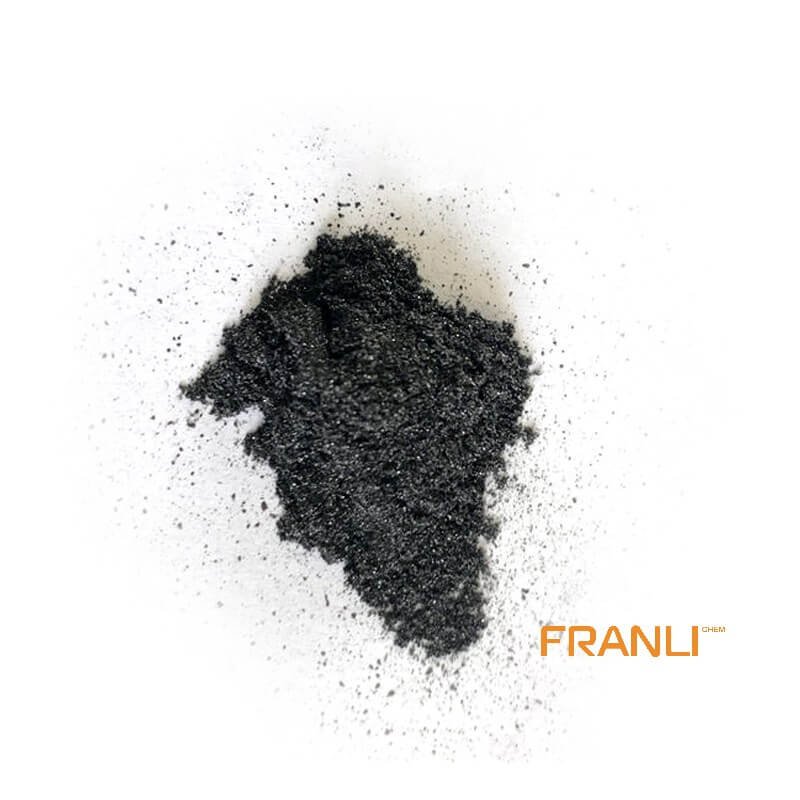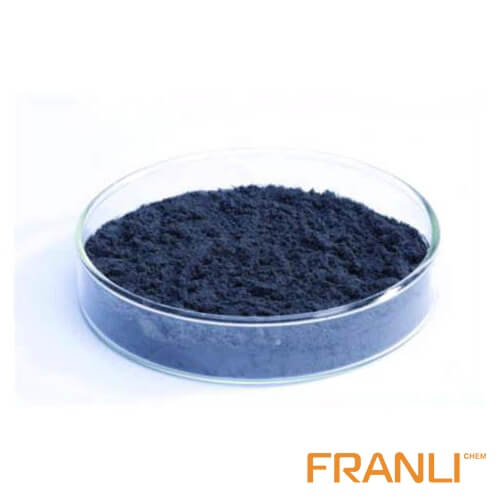



Expandable Graphite
Size
0.50mm or 0.106mm, etc
Package
25 kg small bags into ton bags
Origin
China
Features
Preservative/Electrical and thermal conductivity, etc.
Application
Fireproof sealing element, flame retardant, refractory brick, etc.
Expandable graphite crystal is a typical layered carbon material. Other heterogeneous particles such as atoms, molecules, ions, and even atomic clusters are inserted into the interlayer of crystalline graphite by physical or chemical methods to form a new layered compound, which is called graphite interlayer compound, namely expandable graphite.
Request a quote
There are many ways to prepare expandable graphite, we should learn different preparation methods in order to make higher specifications of expandable graphite
Expandable graphite was prepared from Panzhihua natural flake graphite with sulfuric acid, nitric acid, and perchloric acid as intercalation agents and potassium permanganate as oxidant. The drying temperature, drying time, and expansion temperature of the three processes were tested under the optimum ratio. The results show that the expanded volume of expanded graphite prepared by perchloric acid and potassium permanganate is the largest, reaching 185.7 ml / g. XRD and SEM were used to analyze the structure and morphology of natural flake graphite, expandable graphite, and expanded graphite. The results also show that perchloric acid is more suitable for the preparation of composite phase change materials.

Panzhihua area in Sichuan Province is rich in graphite resources. Graphite is the main raw material for preparing expandable graphite, and expandable graphite is widely used. Many scholars have done a lot of research on the preparation of expandable graphite, and the ratio of expandable graphite prepared from different raw materials is also different. On the basis of reading the literature on the preparation of expandable graphite in recent years, three simple and effective methods were selected, and Panzhihua natural flake graphite was used as raw material to prepare expandable graphite, which was the basis for the preparation of energy storage materials. The energy storage material made of expandable graphite is used to store the solar energy resources in Panzhihua, which not only realizes the optimal utilization of resources, but also realizes energy conservation and emission reduction, and has a good development and application prospect.
In the preparation process of expandable graphite, the intercalation agent is mainly acid. In recent years, researchers have mainly used sulfuric acid, nitric acid, phosphoric acid, perchloric acid, mixed acid, and glacial acetic acid. In the process of preparation, the selection of oxidants is also very important. Too little oxidant or weak oxidation ability, small oxidation effect, difficult to expand interlayer spacing, intercalation agent is not easy to enter the interlayer, affecting the expansion volume. However, if there are too many oxidants, the graphite will be oxidized and the product performance will be reduced. In recent years, researchers have often used potassium permanganate, potassium dichromate, chromium trioxide, and hydrogen peroxide as oxidants.
On the basis of understanding the preparation process of domestic expandable graphite in recent years, three different schemes were selected to prepare expandable graphite. The basic principles of scheme selection: according to the principle of non-toxic and pollution-free, the heavy metals involved in the scheme are not adopted, and the compounds containing cadmium are the main ones, and 1, 13, 14, 19, 20, and 23 are excluded; Low cost, simple process principle, high production cost, and poor safety when using mixed acid, 2, 3, 4, 5, 9, 11, 12, 15 and 16 are not selected; The scheme with large expansion volume and many uncertain factors is the first choice, and the same intercalation agent scheme is only one. According to the above four principles, six, seventeen, and twenty-two methods are selected as the final plan for preparing expandable graphite.
1 Experiment
1.1 Experimental instruments and drugs
Experimental instrument: muffle furnace, Beijing Yongguangming Medical Instrument Co., Ltd; Shz-d (III) circulating water type multipurpose vacuum pump, Henan Yuhua Instrument Co., Ltd; 101-2es electric heating constant temperature blast drying oven, Beijing Yongguangming Medical Instrument Co., Ltd; Dzkw-4 constant temperature water bath, Jiangsu Jinyi Instrument Technology Co., Ltd; Wt10002 electronic balance, Hangzhou want weighing instrument Co., Ltd; Upk-1-10t ultra-pure water meter, Chengdu ultra-pure Technology Co., Ltd; Dx2700 X-ray diffractometer, Dandong Haoyuan Instrument Co., Ltd; Em3200 scanning electron microscope, Beijing Zhongke Keyi Co., Ltd.
Experimental drugs: sodium hydroxide, hydrochloric acid, sulfuric acid, potassium permanganate, hydrogen peroxide, nitric acid, perchloric acid, all chemical reagents are analytical grade, Panzhihua natural flake graphite (carbon content 94% – 95%), all water is prepared by the pure water meter.
1.2 Experimental methods
1.2.1 Purification of natural flake graphite
The carbon content of the fixed graphite used in the experiment is 94%. Before preparation, the natural flake graphite was purified by the process of Li Yufeng et al.
1.2.2 test of expansion volume
Expansion volume is the volume change of expandable graphite after expansion (unit: ml / g). During the experiment, the expansion volume was measured by the experimental method of Zhou Danfeng et al. The expandable graphite with a mass of about 0.1 g was quickly added into the corundum crucible which was burned to a certain temperature. After the expansion was complete, the volume was measured by measuring the cylinder.
1.2.3 Characterization of samples
The structure and morphology of the samples were analyzed by XRD and SEM.
2. Results and discussion
2.1 Determination of drying temperature and time
Expandable graphite was prepared by means of pangxiuyan et al. (scheme 1), painting text words, etc. (scheme 2) and [6], and no test was carried out on the expansion temperature, drying temperature, and time. Through reading literature, 50 ℃ and 60 ℃ were used as drying temperatures for single-factor experiment analysis, and the expansion temperature was 900 ℃.
(a) is the test results at drying temperature of 50 ℃, the maximum expansion volume of scheme 1 appears about 3 hours in drying time, and both scheme 2 and 3 are about 5 hours( b) The results show that the expansion volume of scheme 1 and 2 is about 3 hours and scheme 3 is about 5 hours. According to the best conditions of scheme 1 of energy conservation principle, 50 ℃ and 3 hours; The best conditions of scheme 2 were 60 ℃ and 3 hours; The best conditions of scheme 3 are 50 ℃ and 5 h.

2.2 Determination of expansion temperature
On the basis of the above experiments, the expansion temperature was tested, and the specific results are shown in 2. (a) in the figure is the expandable graphite prepared under the optimal conditions in (a) in 1, and the relationship between the expansion temperature and expansion volume. It can be seen from the figure that the expansion volume of scheme 1 and scheme 2 always increases with the increase of expansion temperature. Since the maximum test temperature is 900 ℃, the expansion temperature of these two schemes under this condition is determined to be 900 ℃, and scheme 3 decreases after the linear increase, with the maximum value appearing at about 600 ℃. In scheme B, the maximum expansion volume of schemes 2 and 3 is about 700 ℃, while scheme 1 is increasing all the time. The experimental results show that the expansion temperature and maximum expansion volume of the three schemes are 900 ℃ and 99.1 ml / g respectively; 5 ml / g at 700 ℃; 7 ml / g at 600 ℃. The test results of expansion volume show that the results of scheme 1 and scheme 2 are far less than the values in literature because the super large flake graphite used in the literature and is larger than 150 μ The size of natural flake graphite is not uniform. The expansion volume of scheme 3 is larger than that of reference because ultrafine flake graphite is used in the reference.
2.3 Structural analysis of materials
(A ) is natural flake graphite, (b) is purified graphite, and its characteristic peaks appear in 2 θ 6 ° And 54.7 ° The peak intensity changes little( c) Compared with natural flake graphite, the peak strength of expandable graphite prepared by (d) and (E) decreased rapidly, which was due to the destruction of graphite crystal structure by oxide intercalation.
The main peaks of natural flake graphite and purified graphite show small separation peaks, which indicates that the structure of raw materials is damaged to some extent. In addition, the position of the main peak of expandable graphite has no large shift, which indicates that no chemical reaction occurs after the intercalation( e) It shows that the oxidation intercalation is the most sufficient, which is consistent with the test results of expansion volume.
2.4 Analysis of SEM results
SEM was used to analyze the morphology of the material. The expansion volume of expandable graphite prepared by perchloric acid as an intercalation agent is the largest, so this scheme is only used to analyze the expanded graphite, so as to better understand the microstructure changes of natural flake graphite after oxidation intercalation and high-temperature expansion. (a) and (b) in the figure are the morphologies of natural flake graphite and expandable graphite prepared in the third scheme, respectively. The natural flake graphite is a flake and closely arranged between layers, and the expandable graphite has an obvious stratification phenomenon, indicating that the intercalation agent has entered the interlayer( c) And (d) are the results of 200 and 500 times magnification of expanded graphite prepared by this method. After expansion, the shape of expanded graphite changes greatly, showing the vermicular shape and a large number of pores, which provide raw materials for the preparation of composite phase change materials in the next step.

3 Conclusion
Three methods were used to prepare expandable graphite, and the unidentified factors in the methods were compared by single-factor experiments. The structure and morphology of the products were analyzed
(1) when sulfuric acid and potassium permanganate were used as intercalation agents and oxidant, the optimum drying temperature, drying time, expansion temperature, and maximum expansion volume were 50 ℃, 3 h, 900 ℃ and 99.1 ml / g, respectively;
(2) when nitric acid and potassium permanganate were used as differential layer and oxidant, the optimum drying temperature, drying time, expansion temperature, and maximum expansion volume were 60 ℃, 5 h, 700 ℃ and 134.5 ml / g, respectively;
(3) when perchloric acid and potassium permanganate were used as differential layer and oxidant, the optimum drying temperature, drying time, expansion temperature, and maximum expansion volume were 50 ℃, 5 h, 600 ℃ and 185.7 ml / g, respectively. Under these conditions, the expanded graphite had the largest expansion volume and the best porosity, which was more suitable for the preparation of organic composite phase change materials.



